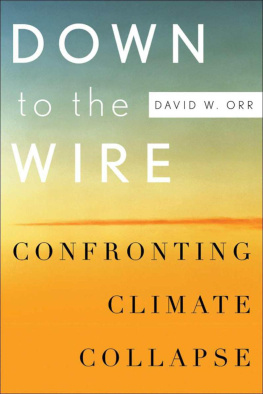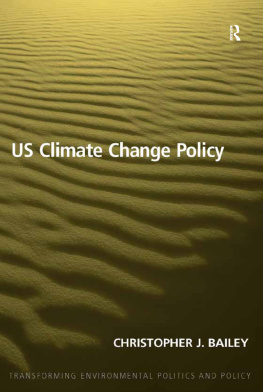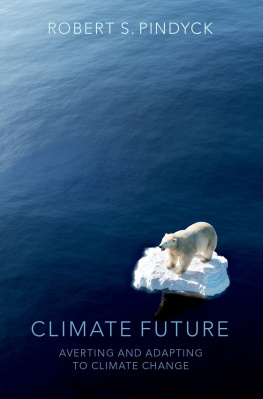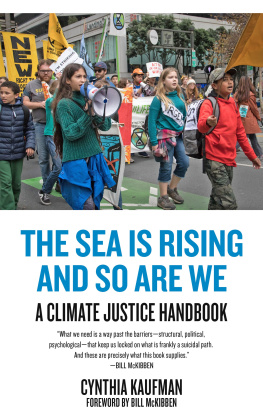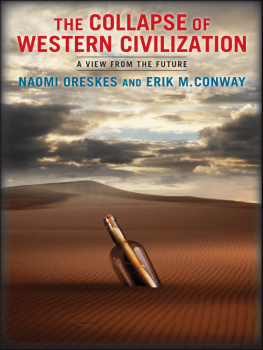Down to the Wire
Other Books by David W. Orr
Ecological Literacy (1992)
Earth in Mind (1994/2004)
The Nature of Design (2002)
The Last Refuge (2004)
Design on the Edge (2006)
The Global Predicament,
coedited with Marvin S. Soroos (1979)
The Campus and Environmental Responsibility,
coedited with David G. Eagan (1992)
The Sage Handbook of Environment and Society,
coedited with Jules Pretty et al. (2008)
Down to the Wire
Confronting Climate Collapse
DAVID W. ORR


Oxford University Press, Inc., publishes works that further Oxford Universitys objective of excellence in research, scholarship, and education.
Oxford New York
Auckland Cape Town Dar es Salaam Hong Kong Karachi
Kuala Lumpur Madrid Melbourne Mexico City Nairobi
New Delhi Shanghai Taipei Toronto
With offices in
Argentina Austria Brazil Chile Czech Republic France Greece
Guatemala Hungary Italy Japan Poland Portugal Singapore
South Korea Switzerland Thailand Turkey Ukraine Vietnam
Copyright 2009 by Oxford University Press, Inc.
Published by Oxford University Press, Inc.
198 Madison Avenue, New York, NY 10016
www.oup.com
Oxford is a registered trademark of Oxford University Press
All rights reserved. No part of this publication may be reproduced, stored in a retrieval system, or transmitted, in any form or by any means, electronic, mechanical, photocopying, recording, or otherwise, without the prior permission of Oxford University Press.
Library of Congress Cataloging-in-Publication Data
Orr, David W., 1944
Down to the wire : confronting climate collapse / David W. Orr.
p. cm.
Includes bibliographical references and index.
ISBN 978-0-19-539353-8
1. Climatic changes. 2. Climatic changesEnvironmental aspects.
I. Title.
QC981.8.C5O77 2009
363.34dc22 2009005584
9 8 7 6 5 4 3 2 1
Printed in the United States of America
on acid-free paper
For my grandchildren Lewis, Molly, Ruby Kate,
and Margaret Eloise.
Contents
Preface
The ongoing disruption of the Earths climate by man-made greenhouse gases is already well beyond dangerous and is careening toward completely unmanageable.
John Holdren
ALL OF US BREATHE FROM THE SAME ATMOSPHERE, DRINK the same waters, and are fed from the land. All of us depend, more than we can know, on the stability of the same biogeochemical cycles, including the movement of carbon from plants to the atmosphere, oceans, soils, and living creatures. All of us are vulnerable to the remorseless workings of the large numbers that govern Earth systems. All of us are stitched to a common fabric of life, kin to all other life forms. All of us are products of the same evolutionary forces and carry the marks of our long journey in time. Each of us is a small part of a common story that began three billion years ago. We are all made of stuff that was once part of stars, and we will all become dust to be remade someday into other life forms. As persons, we are visitors on the Earth for only a brief We have entered an era that Harvard biologist Edward O. Wilson calls the bottleneck (Wilson, 2002, pp. 2241).
This book is written in the belief that we will come through that gauntlet chastened but improved. But it will be trial by fire, hopefully, a tempering process in which we will shed our illusions of being separate from nature and our pretense that we can master nature or each other through violence. On the other side of the bottleneck, maybe we will have gained a clearer vision of the value of life and a deeper understanding of what it means to be stewards and trustees for all life to come. But this is certainly not the only scenario one might imagineperhaps, it is not even very likely. There are darker possibilities with which we must contend and which we must have the foresight to anticipate and the wisdom to avoid.
In the fossil fuel age we lived in the unspoken faith that there are no booby traps for unwary species, as biologist Robert Sinsheimer once put it. Unwittingly we set our own, and now the carbon trap is nearly sprung. Even before the coal and oil age we exploited carbon-rich soils and forests, and that is the history of rising and falling empires and the uneven march of civilization. The trap was founded on ignorance of our impact on the biogeochemical cycles of Earth, which posed no serious problems when we were fewer and depended on sunlight and wind for our energy. But now the six and a half billion of us, soon perhaps to be eight or nine billion, are living carbon-intensive lives. We set the trap and it will now take our most creative and sustained efforts to avert catastrophe, and that will require reducing our carbon footprint from 22 tons per person per year to 12 tons or even less. But even then, when this centuries-long climate storm subsides, it will leave behind a new, warmer climate state that will persist for thousands of years. Thats the basic outlook (Archer, 2009, p. 45).
Even in the near term it is already too late, however, to avert significant disasters, and that is a difficult message to convey without inducing paralysis or denial even among those willing to listen. It is a great deal easier for all of us to hit the snooze button on the alarm clock, go back to sleep, and hope that it all goes away, or to pretend that dire circumstances present only opportunities. Climate change presents opportunities for some, certainly, but for the Tuvalu islanders, the victims of floods and droughts and of larger hurricanes and typhoons, those living in low-lying areas like Bangladesh, and the 150,000 who die each year in climate changedriven weather events, the word opportunity has a peculiarly hollow sound. It will as well for the 250,000,000 or more climate refugees that the United Nations estimates will be homeless by midcentury.
Through the coming decades and centuries of the bottleneck, great leadership at all levels will be essential. We will need leaders first, with the courage to help the public understand and face what will be increasingly difficult circumstances. The primary cause is climate destabilization, described in four consensus reports by the Intergovernmental Panel on Climate Change over 20 years and hundreds of other scientific reports. Often, however, we dismiss bearers of bad news or inconvenient truths until the point of crisis, when reality can no longer be evaded. The mythical figure of Cassandra and the Old Testament prophet Jeremiah were fated to be ignored until it was too late to avoid the dire things they foretold. The same disbelief has greeted the increasingly frequent and rigorous warnings in our time. One of the earliest, for example, was issued by the Council on Environmental Quality in the Carter administration and published in 1980 as the Global 2000 Report (Barney, 1980). The authors catalogued in great detail the scientific evidence about declining ecosystems, climate change, and species loss, along with measures necessary to move the country toward sustainability. But we chose to evade reality and sought refuge in the slogan that it was morning in America again. Three decades later it is twilight, and we live with the ecological, economic, political, and social consequences of our own making.
Second, in the long emergency ahead leaders will need an uncommon clarity about our best economic and energy options. Some choices being proposed by well-funded and highly organized lobbies would commit the nation and the world to courses of action that will lead to unfortunate and irreversible consequences. They will need to understand their relative costs, risks, and benefits, including those over the long term, to avoid making decisions that lock us in to policies that weor our childrenwill someday sorely regret. There are better possibilities that would go a long way toward solving the underlying causes of our problems. But knowing which is which requires that they recognize the difference between the structure of problems and their coefficientsthe rate at which they get worse. In other words, they need to understand the difference between Band-Aids and authentic cures, and that requires that we better understand otherwise obscure concepts like feedback loops, leads, and lags, which is to say how the world works as a unified system (Meadows, 2008). They must see, in other words, the many connections between climate, environment, prosperity, security, and fairness. In this perspective, climate destabilization is not an aberration but a predictable outcome of a system haphazardly created in the dim light of a dangerously incomplete image of reality.
Next page
